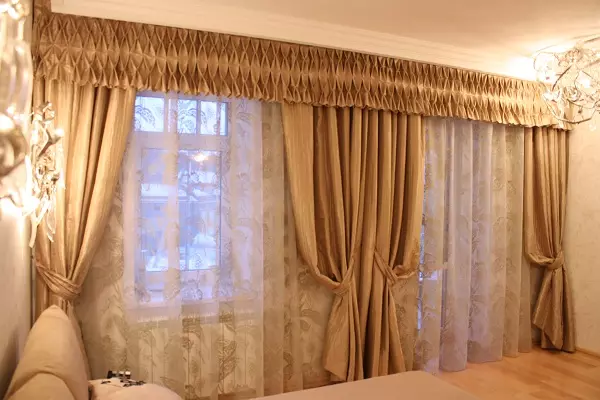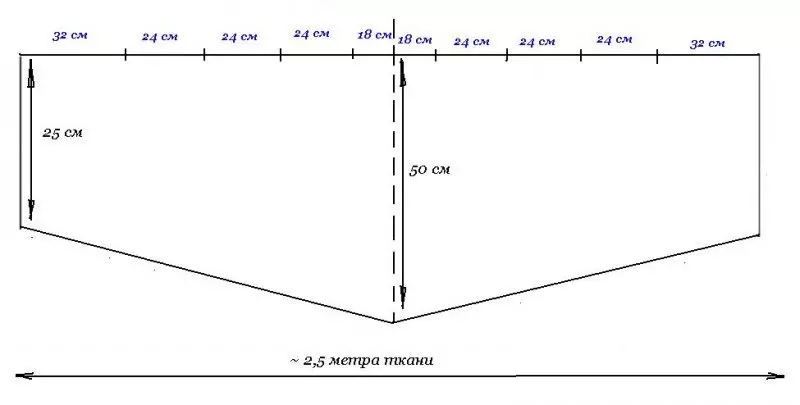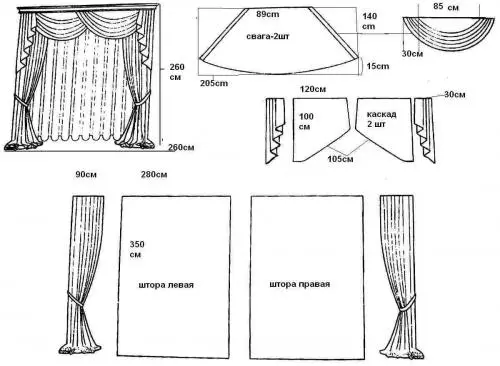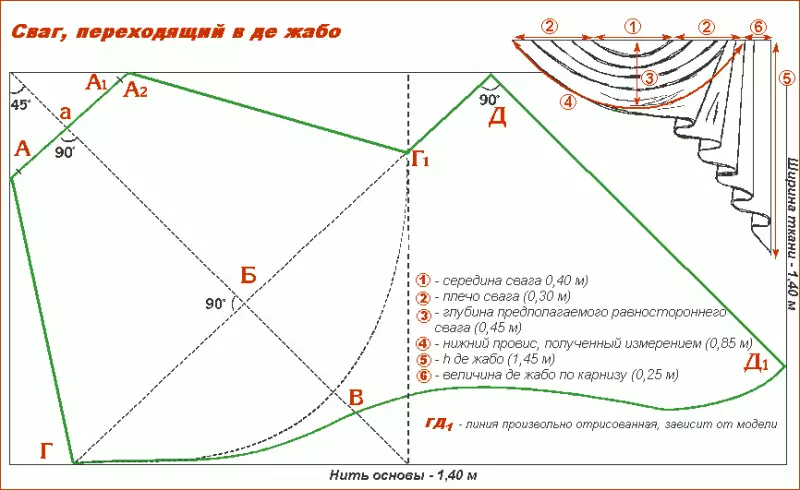The decor of windows plays in the design of the entire premises an important role. Depending on the appearance of the curtain, the room becomes truly cozy or acquires a formal form. With a particular model, the porter can be visually expanding the space or give it a chamber atmosphere. And, of course, the main decoration of any curtain is not a fabric or ornament, but lambrene and other decorative parts.

Lambreken is the main decoration of the curtains.
Not many novice craftsmen are taken for self-sewing curtains and lambrequins, considering their cut too complicated. But if you disassemble any pattern to the components of its details, then no problems will arise. Remember that any, even the most confused design originally consists of simple elements. And if you figure it out in simple patterns, you will cope with the opening of any models.
General principles of lambrequin production technology
The lambrequins for the window curtains are 2 types: hard and soft. The first type of products is called Bando. Although this name is not a model, but a special gasket that gives the items necessary hardness. As a rule, such details of the decor sew from dense materials and often use lining. They are not draped and look like a solid cloth, which often give a fantasy form.

The example was the rigid lambrequin.
Usually, the construction of the pattern of lambrequins of this type does not represent difficulties for beginner masters.
Hard lambrequin can be not only a geometric shape. It is sewing a curtain with fantasy bands is especially complicated and requires certain sewing skills.
Tailoring of the lambrequins of the so-called soft type is much simpler. Usually such decor items look like a beautifully draped part, which is often decorated with additional elements: ties, de zabs, cascades, roses, etc. They sew these decorations made of soft, plastic materials. The lining is rarely used.
In a separate type of decor, you can highlight cakes. In fact, it is also soft lambrequins, but such elements are completely covered with ease of cornice and descend from it like a swing or festoons. At the same time, their pattern is often nothing complicated. A spectacular appearance of the lambrequin depends on the skill of the hostess to drag the fabric around the eaves.
Choosing a porter type
For each of the types of curtains and decorative parts, there is its own tailoring technology. And besides general recommendations that are relevant for each model, there is a mass of individual nuances. Therefore, before you take for work, decide which type you need.
But in any case, it is worth following the advice:
Article on the topic: Loggian glazing technology: Selection of glazing, installation steps

Scheme of sewing conventional curtains with lambrequins.
- Choose models and appearance curtains with lambrequin needed after the overall design of the room has been determined.
- The window design should not visually overload the space. If you have a small room, you should not give preference to multi-tiered curtains with complex lush lambrequins. Conversely, in a spacious bedroom, a modest window decor may look lonely.
- If you rate your sewing skills low enough, then do not get expensive and complex in the processing of fabric. Especially since on the tailoring of the curtain with the lambrequin material it will take a lot.
- The brighter the cloth and more actively drawing, the more modest should be the model of the curtains themselves. Do not choose the complex patterns, implying a large number of decorative elements: folds, drapes, extracts and sublices.
If you follow these non-speed rules, then competently pick up the curtain model for you will not be difficult.
Basic principles of cutting and sewing curtains with lambrequins
Tailoring the curtains with lambrequins implies work with large tissue volumes. Therefore, immediately decide on the place where you will work. Circling curtains is most convenient on the floor. Even a large dining table can be small for this. At the same time, the darous floor covering will help you with a string. It will not give synthetic tissues to slide and shift. But making the pattern of the lambrequin is best on the smooth surface. For example, on a parquet or a wall, attaching paper with a paper tape.
Get the cornice before you start sewing the lambrequins. If you want to make a decor in the form of a peroxide, then when you choose the mount, give preference to the rod, which is made in the form of the letter "C". On such a design, the easiest way to drag and secure fabric.

Long lambrequin should not be more than 1/3 of the height of the curtains themselves.
In addition, you will need the following tools:
- Iron (pre-make sure it has a clean sole);
- Peremnuty (can be replaced by the patch of gauze or fine clean fabric);
- Sewing machine and a set of paws to it;
- well-handed scissors;
- Tools for measurement.
When sewing a lambrequin and a curtain cannot do, of course, without pins, needles, thin threads for the upset and Portnovsky chalk.
Before painting fabric, be sure to perform the necessary measurements. Experienced craftsmen are enough to remove 1-2 measurements. But all measurements and calculations should be carried out very carefully novice portmows.
The first measure is the length of the window cornice. It is necessary to measure the distance between the outer brackets. Next, it is necessary to determine the distance from the cornice to the floor. At the same time, the edge of the edge of the curtains from the cornice is not taken into account. These changes will be made directly into the pattern.
Article on the topic: Suspended ceilings: Characteristics of the main types
The length of the lambrequin and the porter themselves depends only on your tastes and desires. But experienced professionals do not advise you to make this decorative element longer than 1/3 of the curtain height. But ties and cascades can fall much lower.
In addition, it is necessary to remember the important rule: the magnificent lambrene, the longer the curtains should be. Otherwise, the upper design may seem over with a bulky.
Patterns of the main types of lambrequins
The most common curtain design element is a waga. Because the sewing of the lambrequins of this type is very simple. In the finished form of the Swag looks like a swing. Moreover, the decoration of the curtains can consist immediately of several similar details.This type of lambrequin is also convenient because it can be cut out without complex construction of patterns and painstaking calculations.
Approximate scheme of the patch pattern.
It is necessary to determine only the length of 1 part. It should be remembered that 1 Svaga necessarily overlaps another 1/3 width. And each of the elements consists of 3 thirds. Accordingly, to find out the width of the element 1, you need to share the total length of the eaves to the number of used Swag.
That is, if you have a cutter with a length of 270 cm and you are going to use 4 elements for lambrequin, then the calculation is as follows: 270 (Correspond's length) / 4 (SWG number) = 67.5 cm.
Now it is necessary to add 1/3 more from it to this number (the width to which 1 Swag will block another).
67.5 / 3 + 67.6 = 90 cm.
It turns out that the width of the element is 90 cm.
Now you can build a pattern. Take a sheet of paper with the width you need and fold it with a harmonica. Each fold of the harmonica denotes a fold on the lambrene. Therefore, you can form the folds are the same or different in height. Load so many folds, no matter how much you would like to see the curtains on the decoration. Then on the folded sheet, draw the form of the future match and cut it out. You have got ready pattern. The papers on paper indicate labels to form folds on the fabric.
Rounding Festona can also be made without computing. It is enough to attach a lace to the future curtain, imitating the deflection of the swing. And then transfer the result obtained on the pattern. Now you can start sewing lambrequins.
Pattern of the Svagi moving to another element

Svag, turning into de Zabo.
After you have figured out a fairly simple pattern, you can move to the design of more complex options. For example, you can build a milestone of the Swag, which constitutes one unit with the demae element.
First, spend on paper a line that is at an angle of 45 ° to the vertical edge of the sheet. It will indicate the values of the material. Draw a perpendicular to it. The intersection point means folding the fabric. In the drawing, it is indicated as "a". Segments AA and A1A is the distance between the wrenches of the Swag. Add to the right of the A and on the left of the A1 of 10 cm. This is an allowance for the processing of the part.
Article on the topic: Brick barn near a private house: Build your own hands
At the middle line, postpone the length of the Swag and mark the resulting point "B". Lower down on 1/2 Svagi height (edge round). From point B, perform perpendicular trait. It should be equal to the width of the tissue. Then arbitrarily build de zabo and end the creation of patterns of an arbitrary line indicating the bottom of the part.
In many ways, the construction of the pattern of this element depends on the width of the fabric. Therefore, choose a material with a wide cloth (140 cm). Similarly, you can build a lambrene with any element. As a basis, you can take a drawing of a regular guide and attach another element to it. Then the item is cut out as a whole.
After the pattern is completely built, it can be transferred to the fabric. For this, the milestone pins to the material by the portorno pins and drive around the entire perimeter with a chalk or a piece of dry soap. Before opening, do not forget to take into account the allowances for the slices. When you sewing a lambrequin, they usually make up 1-2 cm. Remember that the thinner the fabric, the wider there may be a battery.
Sewing lambrequin for curtains
The sewing of the lambrequins begin with the processing of the upper and lower edges. Moreover, the type of cutting of sections depends on the type of fabric. If you used a sufficiently thin material, you can simply be adjusted. But dense fabric is wiserfully to entee oblique baking. Some craftswomen are used to handle overlock edges. But this is justified only with very thin and transparent tissues. In other cases, the overlock lines may look inactively.
If you design the edge into the bending, then it is more convenient to use a special paw for sewing machines, which is called snail. She herself sends the cloth to the desired width. And the line turns flat and beautiful.
In no case do not pull the material during delay. Otherwise, the item can deform. The tension of the upper and lower thread should be the same. The stitch length is mounted in the range from 2.5 to 3.5 mm.
Then processes the edges of the decorative parts. Make sure that the seams in the connection site did not turn out too tough. To do this, cut the battery to the fold line and cut the cloth to the corner. Otherwise, the machine line can be torn fabric.
The lateral details of the lambrequin are drawn up depending on its type. So, for example, the match is collected on a thread, laying the folds, and processed the cut as a bay or a curtain ribbon.
